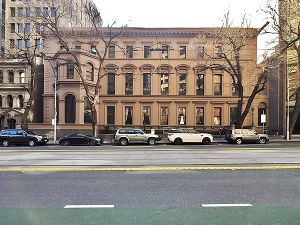Melbourne Club
The Melbourne Club is called by many the headquarters of the Melbourne Establishment with members wielding a powerful influence in Melbourne and Australian life. Since its establishment in 1839, it has become widely regarded as the unofficial power center of Melbourne, although in recent years its influence has perhaps waned a little due to the diversity of business and social networks. It is known as an exclusive Gentleman's club for Melbourne's elite, and the embodiment of tradition, elegance, and old-moneyed sophistication. The club has no female members. The club also offers exclusive accommodation, a library and reading room, and elegant dining facilities.
The club was established at a gathering of 23 Victorian squatters and businessmen in 1838 and initially used John Pascoe Fawkner’s public house on the corner of Collins Street and Market Street. The club's early years were marked by drunkenness, duels, fistfights, and oafishness. It moved to a London-style three-story clubhouse designed by Leonard Terry in 1858 at 36-50 Collins Street, Melbourne, and is located next door to the women-only Lyceum Club and the Naval and Military Club.
The internal operations of the club are secretive with members encouraged not to speak publicly about the club in a powerful code of silence. Membership is by invitation only, with membership numbers in 2001 being reported at just over 1,000 people. According to one news report, the proposing member requires a seconder and four referee members for the nomination to go forward to a ballot open to all members four months later. There is an annual membership fee of $1500, and all services are invoiced on a monthly account.
At the rear of the Club building is a private courtyard garden which is the location of garden parties and private functions. In 2000 there was a dispute over a high-rise redevelopment of the Naval and Military Club at the rear of the two clubs in Little Collins Street. The development causes overshadowing and overview of the private garden.
The Melbourne club building is of architectural significance as a rare intact example of a nineteenth-century purpose-built clubhouse in the Victorian Renaissance style.
It has close reciprocal relations with a number of other clubs of its kind in Australia, most notably the older Australian Club in Sydney.
- Also see the Wikipedia page [ Melbourne Club ]
See also
- Gentlemen's club
- List of American gentlemen's clubs
- List of Australian gentlemen's clubs
- List of London's gentlemen's clubs
Chat rooms • What links here • Copyright info • Contact information • Category:Root
